Summary: Equities rose for a fifth week in a row last week. In many important ways, the current uptrend does not fit the profile of a bear market rally. That means that further gains lie ahead and a return to the February low is unlikely. On a shorter timeframe, there are several compelling reasons to expect a retracement of recent gains in the days ahead
Equities continued to rally for the fifth week in a row. The SPDR S&P 500 Fund (NYSE:SPY) has risen 11 of the past 14 days. SPY, the Nasdaq 100 (NDX) and the Russell 2000 (RUT) all gained over 1% for the week. Emerging markets gained 3%.
Safe havens - Treasuries and gold - which had been in high demand during the sell-off in equities, also gained. Treasuries had sold off the past 4 weeks in a row but gained just over 1% this past week. Gold was up just 0.3%.
Oil has been leading to the upside every week since the bottom on February 11. This past week it was up another 6%. Equities have gained 12% off the bottom; oil is up more than 40%.
The rally in equities is, for now, contingent on oil (via United States Oil Fund (NYSE:USO), below) continuing to move higher. Should the rally in oil fail, it is very likely equities will sell off .

Crude has rallied back above its 50-dma, which has now started to rise. It is staying overbought (top panel). This past week's close was the highest in 3 1/2 months. This remains very constructive action. The next test will be the 200-dma near $43, which was also an important pivot level during September-November.

This post is divided into two sections. The first section describes the intermediate term trend in US equities, with the conclusion that the uptrend does not fit the profile of a bear market rally (meaning, further gains are ahead). The second section describes factors markets may be facing during the next week and reasons to be cautious short-term.
Intermediate-Term Trend
In mid-February, we made two assertions:
First, that the decline in US equities was unlikely to lead to a bear market. In the post-World War II era, only two bear markets have occurred outside of a recession, and the current market and economic environment is nothing like either of those situations (read more here).
Second, that even in the worst case, the upcoming rally would take the indices 7-10% higher (read more here). In the event, the indices are now an average of 12% higher.
Evidence is mounting that the first assertion - that the current rally is not a correction within a bear market - will be accurate. Let's review the rationale.
All of the US indices made new uptrend highs on Friday. The uptrend might feel extended and due for a pause (and there is evidence to that effect below) but the reality is that the indices continue to make new highs. This is the intermediate term trend.
Similarly, 8 of the 9 sectors in the SPX (via sector ETFs Financial Select Sector SPDR (NYSE:XLF), Technology Select Sector SPDR (NYSE:XLK), Consumer Discretionary Select Sector SPDR (NYSE:XLY), Industrial Select Sector SPDR (NYSE:XLI), Energy Select Sector SPDR (NYSE:XLE), Materials Select Sector SPDR (NYSE:XLB), Utilities Select Sector SPDR (NYSE:XLU), Health Care Select Sector SPDR (NYSE:XLV), Consumer Staples Select Sector SPDR (NYSE:XLP), iShares Transportation Average (NYSE:IYT)) made new uptrend highs in the past two market days. These 8 also have yawning MACDs (lower panel). There is no evidence of creeping deterioration in upward momentum.

SPY is now positive for the year after this past week's rally. Importantly, 7 of the 9 sectors are also positive for the year. This is a broad-based uptrend.
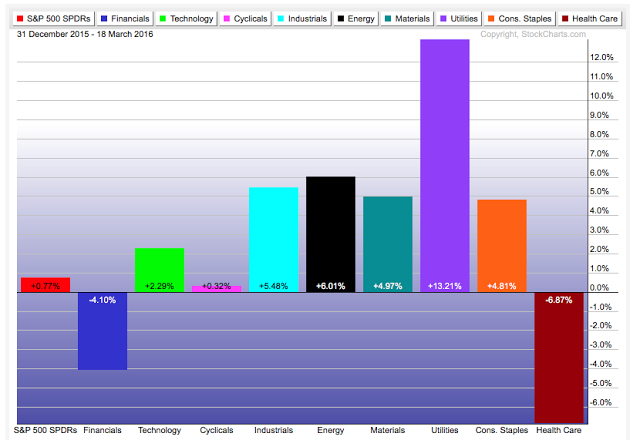
Breadth is unusually strong. Over 50% of the stocks in the broad NYSE Index are back above their 200-dma. Drops below 20% have happened 4 previous times since 2000. Upturns from those levels marked the end of two bear markets and the steep correction in 2011; the move back above 50% helped confirm the market upturn. This is not the breadth profile of a bear market rally (from John Murphy; his original chart is first, followed by an updated chart from Friday).

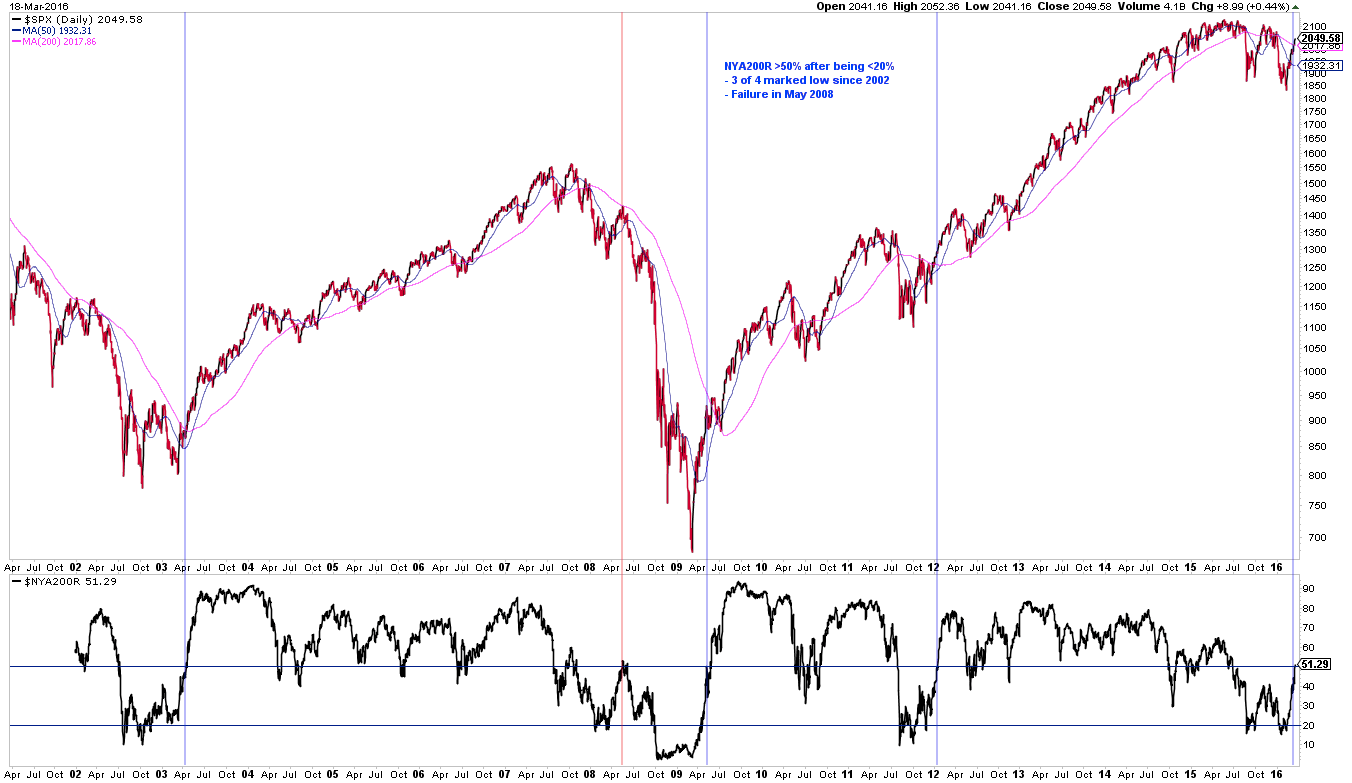
Moreover, the momentum in breadth is unusually strong. In neither the 2000-02 nor 2007-09 bear market did a countertrend rally take the Summation Index over 850; in fact, most ended under 500. That was especially true of the failed March-May 2008 rally (red line above). On Friday, Summation closed over 910. This is not the breadth momentum profile of a bear market rally.

Price momentum is also uncharacteristic of a countertrend rally. Below is a weekly chart for SPY. Rallies failed during the 2000-03 and 2007-09 bear market when momentum reached 70; that's also where the rally after the 20% fall in 2011 failed. This past week, momentum reached 75 (top panel). Next, look for the MACD line to cross over zero for further confirmation of the uptrend (lower panel).
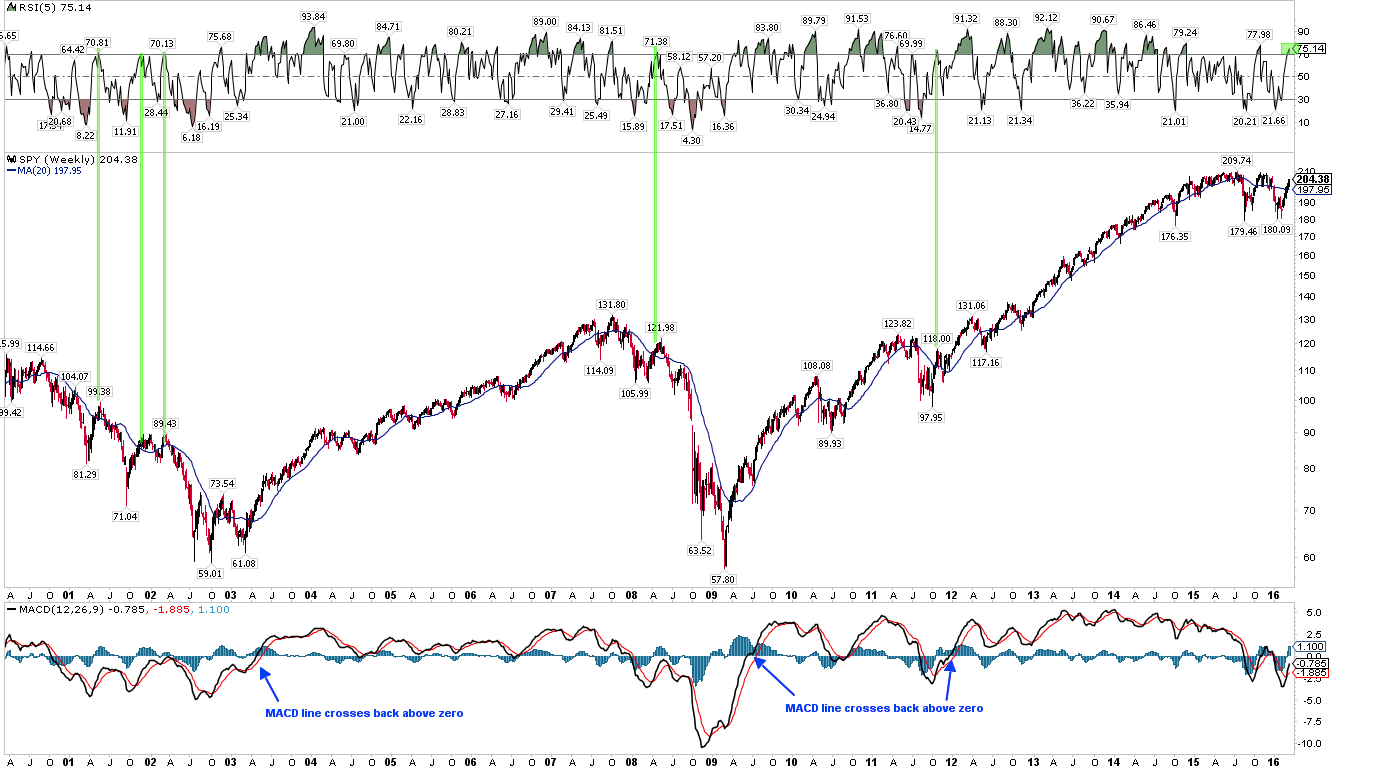
SPY is now trading more than 2% above its monthly 20-ma (blue line). In the past two bear markets, a rally that failed to close back above that 20-ma has led to a deep contraction. A close above 200 at the end of March would be another bullish confirmation of the uptrend.

Most countertrend rallies retrace 38-50% of the fall from the peak in price. An exceptionally strong countertrend rally will retrace 62% of the fall. SPY has now retraced 79% of the fall from the November high to the February low. This is outside the range of even the strongest bear market rallies. This is not the profile of a countertrend rally.
All of the US indices are now back within their prior trading range from 2015. They have overcome the resistance from breaking the range lows.
SPY closed at a new uptrend high on Friday and is now positive for the year. Surprisingly, filling the gap from December 31 offered little resistance. Both the 13-ema and now also the 50-dma are rising. Note how momentum has remained overbought throughout this uptrend (top panel). Sidelined money has had to chase the rally and shorts have had no easy escape. That is a bullish profile. So long as RSI remains over 50 and the slope of the 13-ema remains positive, the intermediate trend will be higher.

Even on a shorter timeframe (hourly), SPY has (1) held its rising 5-dma (green line) and (2) remained mostly "overbought" (top panel). This uptrend is not showing signs of weakening. On a retracement, watch if the slope of the 5-dma, now near 202, remains positive and whether momentum remains under 30 only briefly. On strength, the November and December pivot highs are resistance, near 206.
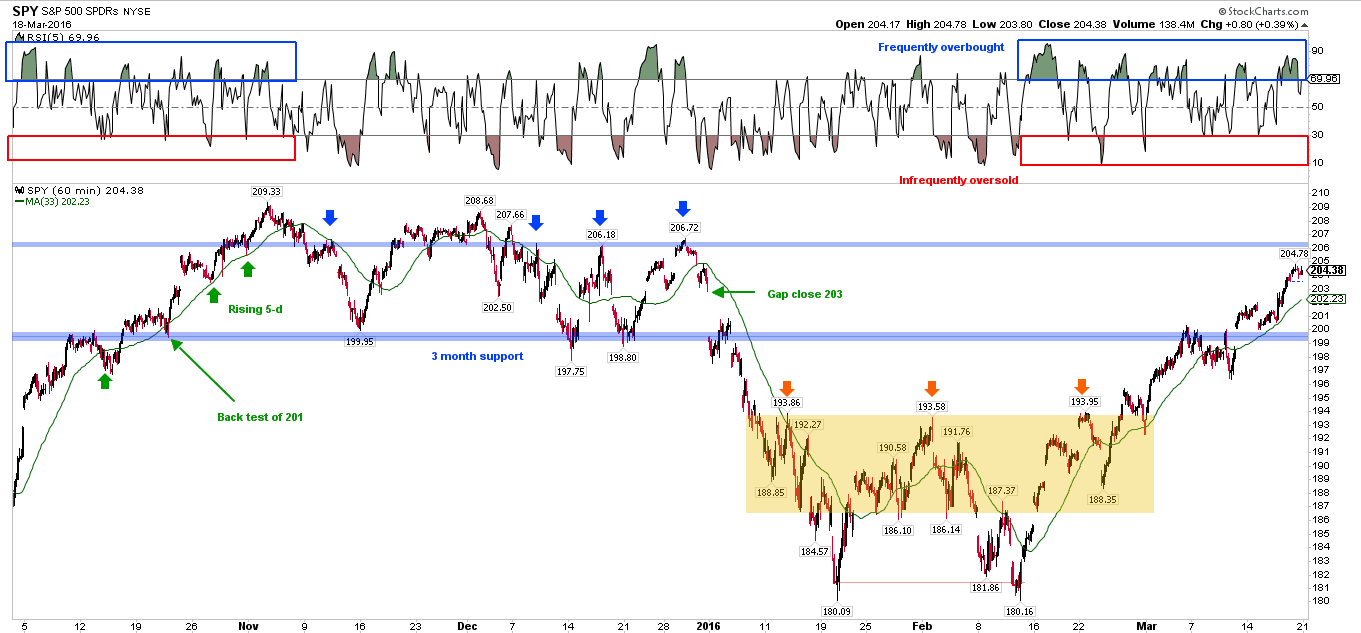
NDX has gained as much as SPY has from the low, but it is farther from its prior high. The index has little exposure to energy or materials and so did not benefit ffrom the rebound in those sectors. It barely regained its prior range this past week.
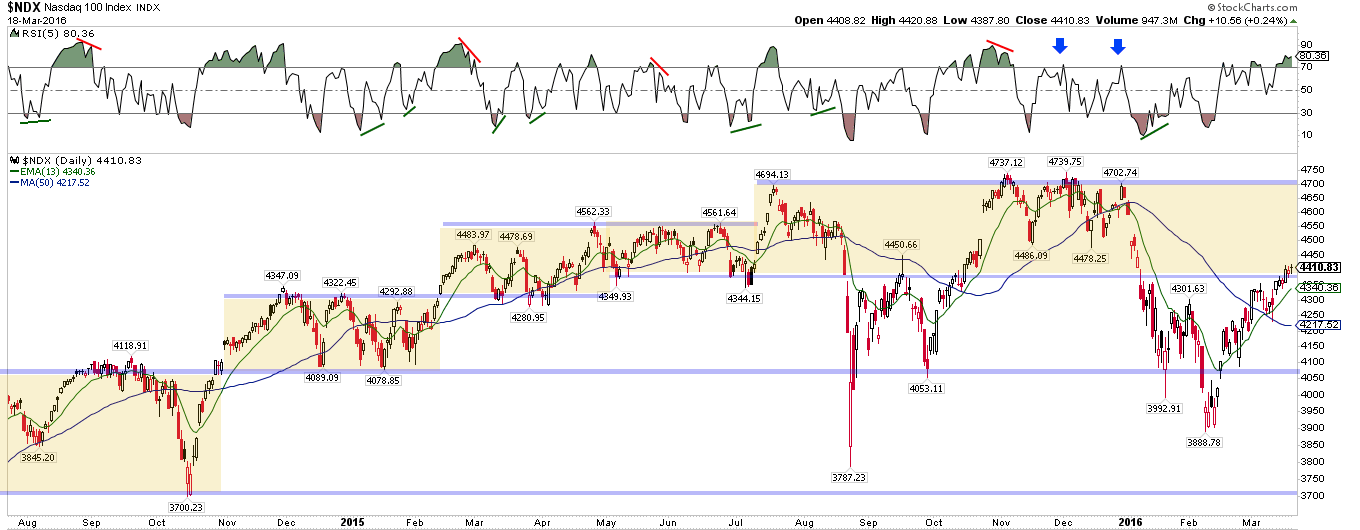
Small caps have led off the lows, gaining 15%. This has been a positive contributor to the breadth of the rally. Like the others, it has regained its prior range. Note, however, that momentum is waning (top and bottom panel arrows). This is a watch out heading into the coming week.
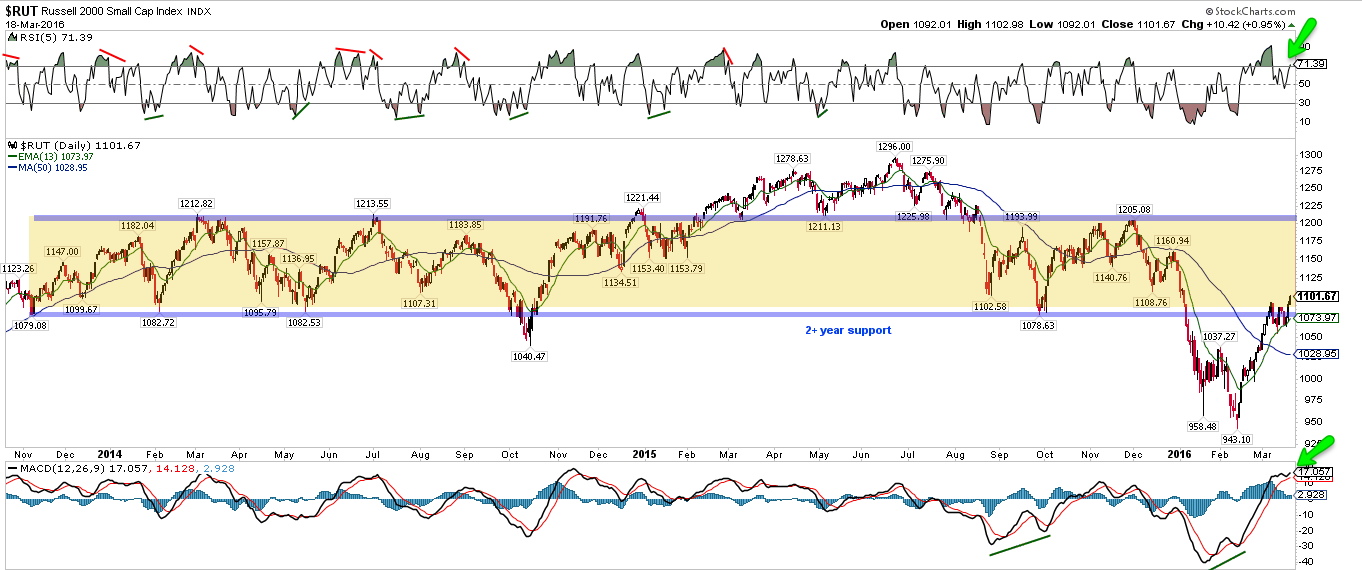
Despite an average gain of 12% in equities worldwide over the past month, investors remain skeptical. There is very little evidence that investors fear missing out in the rally; in contrast, that can often be the case after the first counter trend rally in a bear market, as investors retain a bullish bias.
Below is a table summarizing a number of sentiment surveys. Over the past 3 weeks, bullish sentiment has hardly budged. Remarkably, AAII bulls actually declined this past week and is lower than 3 weeks ago. There is little evidence that investors are embracing this rally (from Barron's).
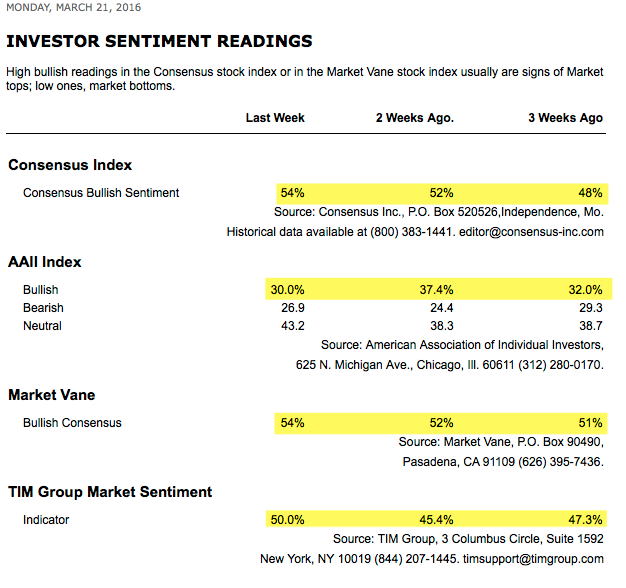
Fund managers surveyed by BAML are defensive: cash balances remain high and allocations to equities have increased only slightly. Relative to bonds, commodities and cash, allocations to equities remain near the lows formed in mid-2010, 2011 and 2012. This is supportive of further gains in equities (from BAML; a new post on this is here).
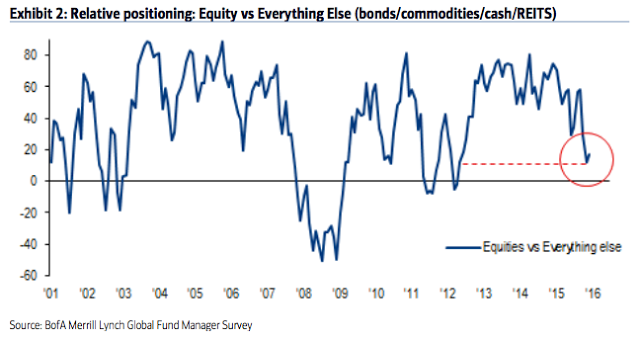
Investors in US equities are particularly defensive: exposure is near an 8 year low and lower than during most of 2008.
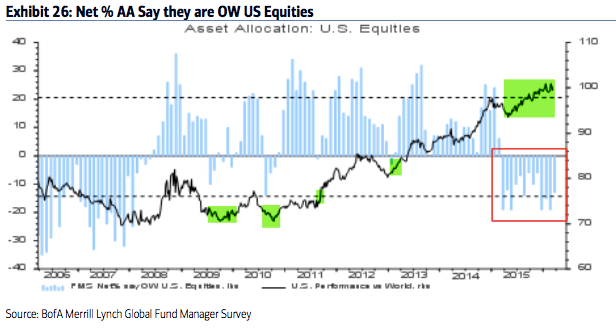
Despite the ongoing rally, money flowed out of equity funds again this past week. Equity fund flows have been negative 14 of the past 16 weeks, longer than any time during the 2007-09 bear market.
Meanwhile, investors have added to the safe haven of bonds 14 weeks in a row. We would expect improvement in investor sentiment before this rally ends. The bear market rally in March-May 2008 included several positive weeks of equity inflows, including one that was more than $20b in one week (from Lipper and Sentimentrader).
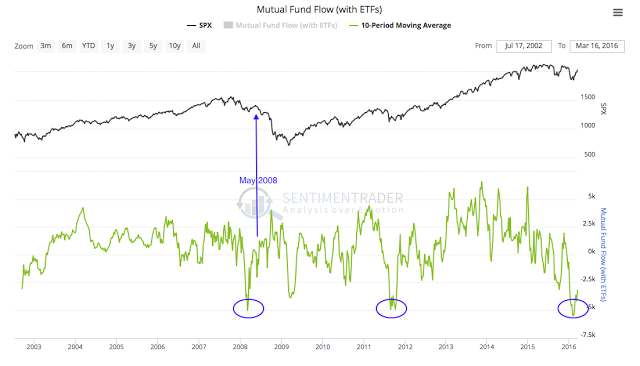
On balance, price action, breadth and sentiment during the current uptrend do not fit the profile of a bear market rally. That means it is unlikely that this rally will roll over and decline to the February lows or lower. The evidence to-date suggests further upside is still ahead.
But that doesn't mean that US markets are set to return 7-10% per year going forward. The return for buy and hold investors is likely to be meagre. This is a point we made in November 2014 when the SPX was at the same level that it is at now. Read that post here.
While macro data continues to be non-recessionary, growth is very slow. The weakest part of the economy is manufacturing: in February, industrial production in manufacturing industries grew 1.8% yoy. This is sluggish, but positive, growth. The mining sector has declined over 10% yoy.

Similarly, corporate revenue and earnings growth is also positive but slow growing. In 2015, revenues were flat and EPS grew about 2%. Energy EPS fell by more than 60% due to the collapse in oil prices; those YoY comparables will turn positive in 2016 if oil stabilizes. But even so, the rest of the index is not growing more than by low single digits. That implies modest returns from equities going forward (data from Yardeni).
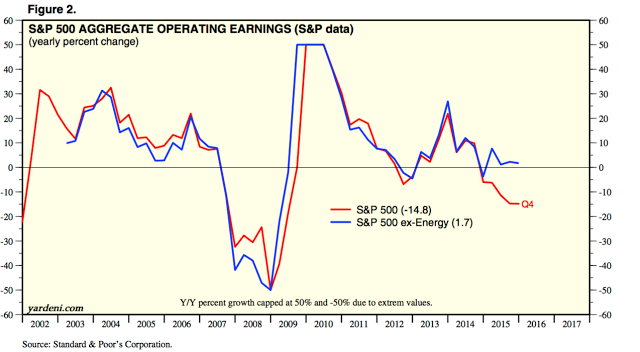
Aside from energy, the biggest wild card to corporate growth is the value of the dollar. The dollar has started to sell off: it is down 5% in the past two months. This has a positive affect on earnings, as EPS and the dollar are inversely correlated.
Just as the rise in the dollar negatively impacted EPS in 2015, stabilization or reversal in the dollar would be a tailwind to growth in 2016 (data from Yardeni):
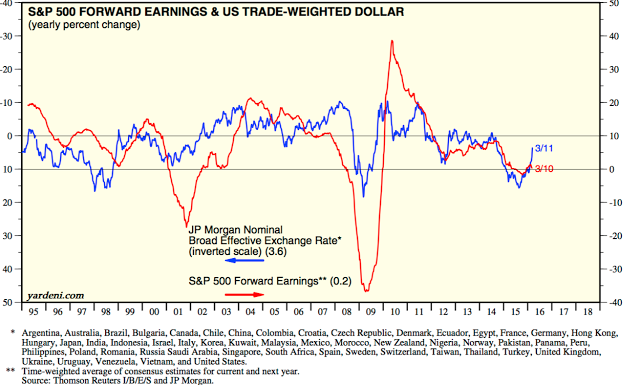
The Week Ahead
Within the context of the positive market environment described above, there are several reasons to be cautious short-term.
First, SPY is up 10% in 5 weeks. This rate of advance is rare. Most often, the index then consolidates or retraces (orange lines); if there are further gains, they are shortly given back. Early 2009 was the main exception.

Similarly, SPY is now more than 6% above its 50-dma. That level of extension has most often led to poor, short-term, risk-reward. Early 2011 was the main exception (from John Krinsky).
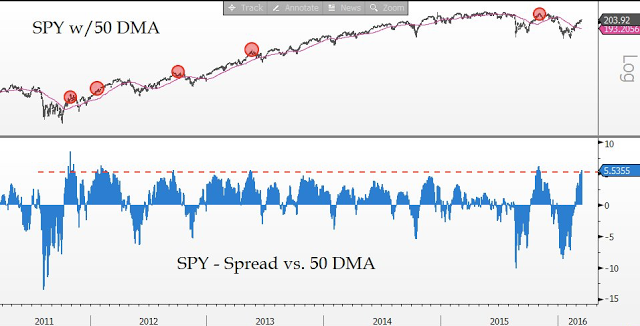
The volatility index (VIX) fell 15% this past week and has fallen by more than half since February 11. When VIX (1-month volatility) is less than 80% of VXV (3-month volatility), SPY normally struggles to make any gains, and most often retraces in the week(s) ahead.
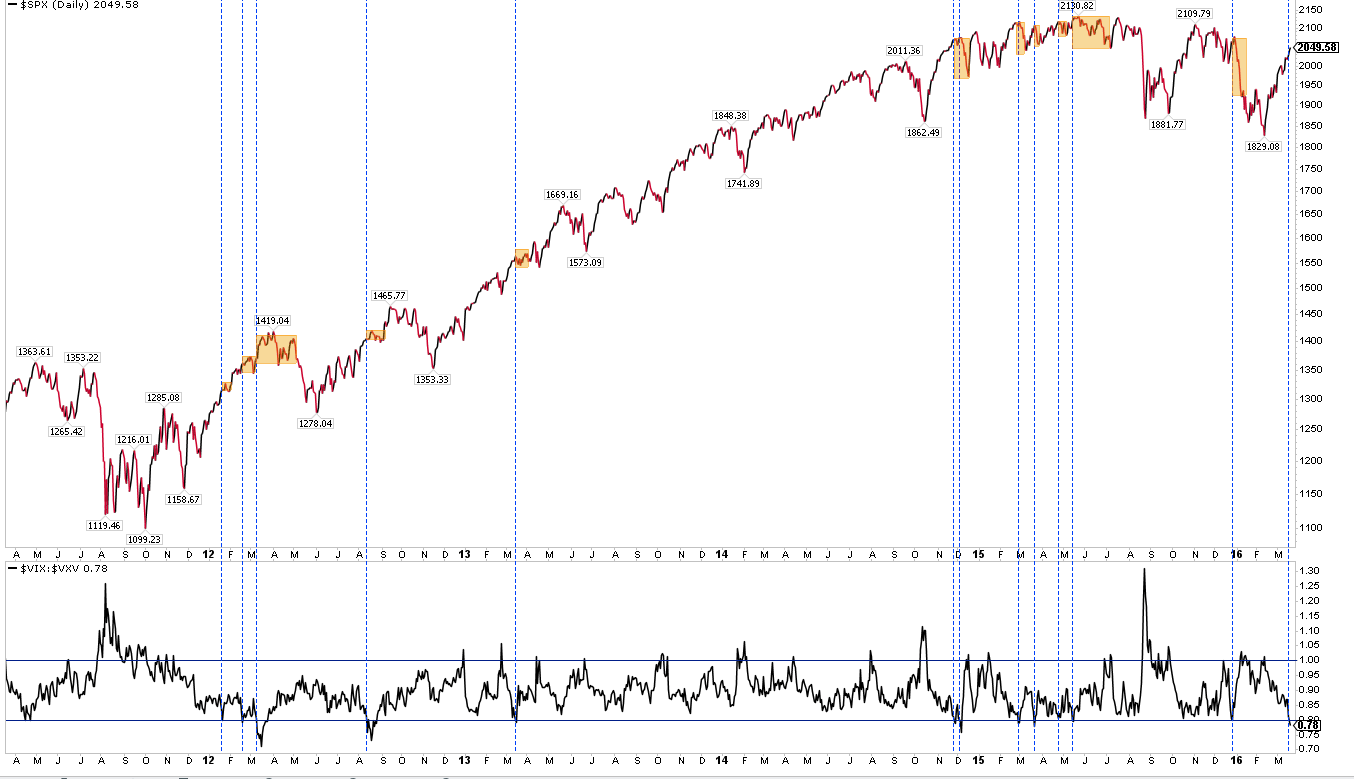
Note, however, that over the next month, the large fall in VIX is a positive for SPY. SPY has been at the same level or higher more than 80% of the time after similar falls in VIX over a 5 week period (from Charlie Bilello).
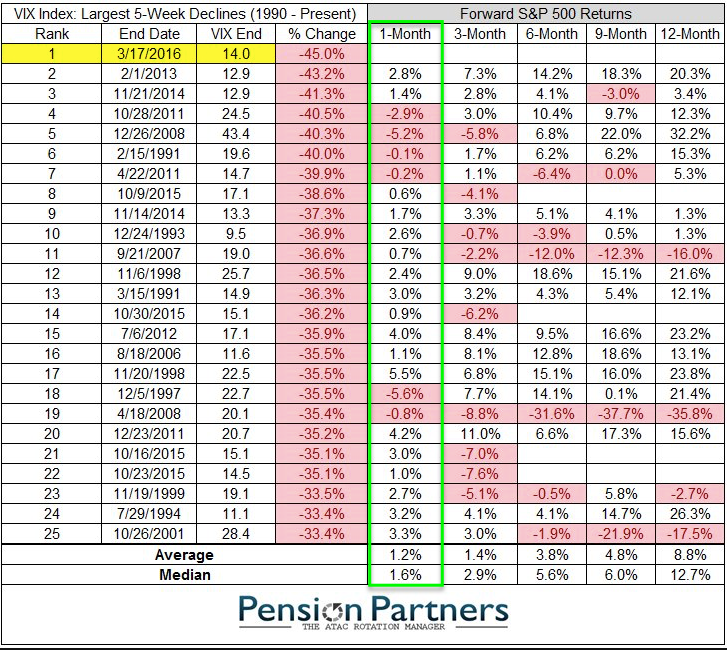
The gains this past week came during seasonally positive March OpX. The week after is positive only 30% of the time. Furthermore, March OpX week and the week following have both been positive only 15% of the time in the past 30 years.

The indices enjoyed a positive trend up through this past week's FOMC meeting. Most often, a strong run up into FOMC leads to a retracement over the following 10 days (green line; from Stock Traders Almanac).
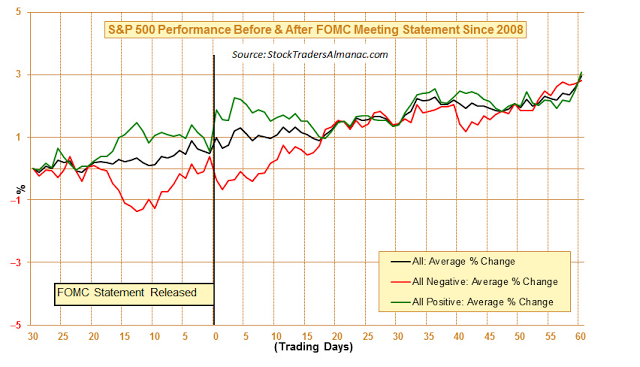
Finally, the total put/call ratio fell below 0.7 on Thursday, the lowest since August 10 which preceded the steep fall in equities later that month. Over the past 5 years, SPY has closed lower than the day of the low put/call at least once more than 80% of the time. That implies a close below 203.6 by Thursday. The average decline is 0.8%, implying a close near 202 this week (from Index Indicators).

Taken together, the extended gain, drop in volatility, seasonality and extreme in put/call suggest a downside edge in the week ahead. A drop to 200-202 would be unsurprising, nor would it impair the intermediate-term uptrend.
The upcoming week is shortened by Good Friday. The economic calendar is busy: new home sales on Wednesday, durable goods on Thursday and GDP on Friday.
In summary, equities continue to make new uptrend highs. In many important ways, the current uptrend does not fit the profile of a bear market rally. That means that further gains lie ahead and a return to the February low is unlikely. On a shorter timeframe, there are several compelling reasons to expect a retracement of recent gains in the days ahead.
